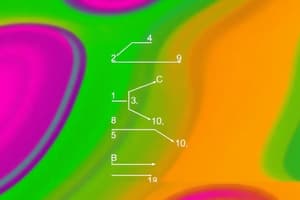Podcast
Questions and Answers
What is the main goal of expression trees?
What is the main goal of expression trees?
- To implement virtual functions
- To enhance code modularity
- To simplify memory allocation
- To represent arithmetic expressions (correct)
Expression trees can only represent binary operators.
Expression trees can only represent binary operators.
False (B)
What is one disadvantage of using a single node type for expression trees?
What is one disadvantage of using a single node type for expression trees?
Memory wastage
The operator for a constant in an expression tree is represented as '__'.
The operator for a constant in an expression tree is represented as '__'.
Match the following components of the expression tree with their descriptions:
Match the following components of the expression tree with their descriptions:
Which of the following functions is responsible for evaluating an expression tree?
Which of the following functions is responsible for evaluating an expression tree?
The eval function is modular and does not require dissection of the node structure.
The eval function is modular and does not require dissection of the node structure.
What does the presence of 'virtual' in a member function indicate?
What does the presence of 'virtual' in a member function indicate?
Without the keyword 'virtual', the static type determines which function is executed.
Without the keyword 'virtual', the static type determines which function is executed.
What does the 'eval()' member function return in a Literal type?
What does the 'eval()' member function return in a Literal type?
The class __________ is an abstract class since it does not implement the eval function.
The class __________ is an abstract class since it does not implement the eval function.
Match the following classes to their descriptions:
Match the following classes to their descriptions:
What is the purpose of the size() function in the Addition class?
What is the purpose of the size() function in the Addition class?
The 'Addition' class inherits both member variables and functions from the 'Exp' class.
The 'Addition' class inherits both member variables and functions from the 'Exp' class.
What attributes does the BinExp class hold?
What attributes does the BinExp class hold?
To call the constructor of the base class in Addition, __________ is used.
To call the constructor of the base class in Addition, __________ is used.
What is the significance of polymorphism in object-oriented programming?
What is the significance of polymorphism in object-oriented programming?
Inheritance allows derived classes to completely replace the implementation of their parent classes.
Inheritance allows derived classes to completely replace the implementation of their parent classes.
What allows a dynamic type to determine which function is invoked during runtime?
What allows a dynamic type to determine which function is invoked during runtime?
In object-oriented programming, a class that inherits from another class is known as a __________.
In object-oriented programming, a class that inherits from another class is known as a __________.
Match the concepts related to object-oriented programming:
Match the concepts related to object-oriented programming:
What does the Times::eval() method primarily do?
What does the Times::eval() method primarily do?
The Times struct inherits from Exp.
The Times struct inherits from Exp.
What would need to happen for the Addition::eval() and Times::eval() methods to be unified?
What would need to happen for the Addition::eval() and Times::eval() methods to be unified?
The tnode structure includes members for a double value val and a character for the operation, represented by ___.
The tnode structure includes members for a double value val and a character for the operation, represented by ___.
Match the following structs with their corresponding operations and evaluations:
Match the following structs with their corresponding operations and evaluations:
Which operation is NOT directly implemented as a class derived from Exp?
Which operation is NOT directly implemented as a class derived from Exp?
The tnode structure can handle unknown operators through its methods.
The tnode structure can handle unknown operators through its methods.
What is the purpose of the eval() method within the tnode structure?
What is the purpose of the eval() method within the tnode structure?
Functional programming concepts were deemed ___ for the current course's scope.
Functional programming concepts were deemed ___ for the current course's scope.
Which of the following best describes the inheritance structure in the provided code?
Which of the following best describes the inheritance structure in the provided code?
What does encapsulation in object-oriented programming primarily aim to achieve?
What does encapsulation in object-oriented programming primarily aim to achieve?
A subtype can only support the same functionality as its supertype.
A subtype can only support the same functionality as its supertype.
What does polymorphism allow in object-oriented programming?
What does polymorphism allow in object-oriented programming?
The ______ section of a class contains members that are not accessible to users.
The ______ section of a class contains members that are not accessible to users.
Match the concepts with their descriptions:
Match the concepts with their descriptions:
Which of the following is true about static dispatch in object-oriented programming?
Which of the following is true about static dispatch in object-oriented programming?
Private inheritance is a feature that lets derived classes inherit all public members of the base class.
Private inheritance is a feature that lets derived classes inherit all public members of the base class.
What is the role of an abstract supertype in a type hierarchy?
What is the role of an abstract supertype in a type hierarchy?
In object-oriented programming, members that are accessible to users and provide functionality are defined in the ______ section.
In object-oriented programming, members that are accessible to users and provide functionality are defined in the ______ section.
Which statement best describes multiple inheritance?
Which statement best describes multiple inheritance?
Flashcards
Expression Tree
Expression Tree
A tree-like data structure representing arithmetic expressions.
Modularization
Modularization
A technique for organizing code by separating concerns and making code more reusable.
Type Hierarchies
Type Hierarchies
A hierarchy of classes where subclasses inherit properties and methods from parent classes.
Virtual Functions
Virtual Functions
Signup and view all the flashcards
Dynamic Binding
Dynamic Binding
Signup and view all the flashcards
Code Reuse
Code Reuse
Signup and view all the flashcards
Concepts of Object-Oriented Programming
Concepts of Object-Oriented Programming
Signup and view all the flashcards
String
String
Signup and view all the flashcards
Inheritance
Inheritance
Signup and view all the flashcards
Constructor
Constructor
Signup and view all the flashcards
Polymorphism
Polymorphism
Signup and view all the flashcards
Base Class
Base Class
Signup and view all the flashcards
Derived Class
Derived Class
Signup and view all the flashcards
Abstract Class
Abstract Class
Signup and view all the flashcards
BinExp Class
BinExp Class
Signup and view all the flashcards
Times Class
Times Class
Signup and view all the flashcards
Times::eval()
Times::eval()
Signup and view all the flashcards
Literal Class
Literal Class
Signup and view all the flashcards
Addition Class
Addition Class
Signup and view all the flashcards
Addition::eval()
Addition::eval()
Signup and view all the flashcards
Cos::eval()
Cos::eval()
Signup and view all the flashcards
Specialized Subtypes
Specialized Subtypes
Signup and view all the flashcards
Overriding
Overriding
Signup and view all the flashcards
Encapsulation
Encapsulation
Signup and view all the flashcards
Subtyping
Subtyping
Signup and view all the flashcards
Static Dispatch
Static Dispatch
Signup and view all the flashcards
Overridden Member Function
Overridden Member Function
Signup and view all the flashcards
Multiple Inheritance
Multiple Inheritance
Signup and view all the flashcards
Virtual Member Function
Virtual Member Function
Signup and view all the flashcards
Upcasting
Upcasting
Signup and view all the flashcards
Study Notes
Subtyping, Inheritance and Polymorphism
- Subtyping, inheritance, and dynamic binding enable modularization through specialization
- Inheritance enables sharing common code across modules, avoiding code duplication
- The type hierarchy of expressions (e.g., Exp, Literal, Addition, Times) allows subtypes (e.g., Literal) to be used in places where supertypes (e.g., Exp) are expected
- This is because of the subtype relation in the hierarchy
- A variable of type Exp can hold expressions of different dynamic types, such as Literal or Addition
- Polymorphism and dynamic dispatch are essential concepts in this context
- Executed member functions of a subtype are determined by the dynamic type, not the static type in some cases
Expression Trees
- Expression trees represent arithmetic expressions as a tree structure
- Nodes in an expression tree include: literals, binary and unary operators, and function applications
- Using a single node type for expression trees results in inefficiencies, like memory wastage
- Alternate implementations lead to modular, less error-prone evaluation functions
Disadvantages of a Single Node Type
- Every function must "dissect" the "sum" of all required nodes for evaluation
- This approach is complex and error-prone, hindering code modularity
New Concepts Today
- Subtyping
- Polymorphism and dynamic dispatch
Polymorphism and Dynamic Dispatch
- Variables of static type Exp can contain expressions of different dynamic types (e.g., Literal, Addition)
- During execution, member functions for the dynamic type are executed, which promotes Polymorphism
- The member functions execute according to their respective dynamic type, even though the static type is Exp
- Using the dynamic type for the expression is called dynamic dispatch
Inheritance
- Shared functionality among type hierarchy members is implemented only once
- Examples of shared functionality are computing the size of binary expressions (e.g., Addition, Times)
- Functionality is shared across subtypes using inheritance
- Subtypes inherit functionality making it easier to extend the functionality given by the base class or super class
Syntax and Terminology
- Specific structures (Exp, BinExp, Times) are defined as either types or subclasses
- Relationships between types are specified, using the (public) keyword
Abstract Class Exp and Concrete Class Literal
- Abstract class Exp defines members like size and eval (size=0;eval=0) which must be implemented by a concrete class and has no implementations, or concrete class methods, to fulfill the abstract class's structure for a specific dynamic type
- A concrete class Literal implements methods size and eval
Literal Implementation
- The implementation defines size as 1
- The implementation defines eval as the value
Subtyping: A Literal is an Expression
- A pointer to a subtype (Literal) can be used in place of a pointer to a super type (Exp)
- But a pointer to a super type (Exp) cannot be used in place of a pointer to a subtype (Literal) in C++ programming
Polymorphism: A Literal Behaves Like a Literal
- Dynamic types determine the member function to be executed
- Dynamic binding is important in this context
Further Expressions and Operations
- Additional expressions (e.g., -, /, √, cos, log) can be derived from the Exp base class
- Examples are offered in the lecture materials through code demonstrations
Further Expressions: Addition and Times
- Functionality for addition and multiplication of expressions is derived from a shared base class, BinExp, reducing code duplication
Extracting Commonalities - BinExp
- Functionality related to operations on expressions is generalized from base class BinExp
- Functionality associated with expressions is streamlined, using inheritance
- Methods involving expression handling are commonly extracted
Inheriting Commonalities - Addition
- The Addition class inherits core functionality from BinExp and provides its own implementation of the eval method to perform the addition operation
Inheriting Commonalities - Times
- The multiplication operation is handled in a similar way for the Times object
- This class inherits and implements a function override
Object-Oriented Programming Concepts
- Encapsulation (weeks 10-13): Hiding implementation details, defining public interfaces for interaction
- Subtyping (week 14): Type Hierarchies, defining relationships between general and specific types. A subtype can be used where a super-type is required and more features may be added
- Polymorphism and dynamic binding (week 14): Using subtypes as if they were a supertype while handling different underlying functionality based on subtype at runtime.
- Inheritance (week 14): Reduces code-duplication and promotes code reusability
Studying That Suits You
Use AI to generate personalized quizzes and flashcards to suit your learning preferences.




